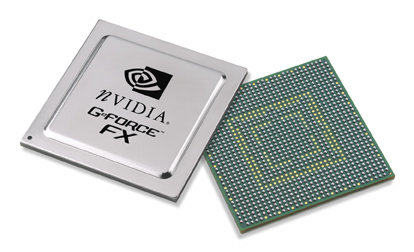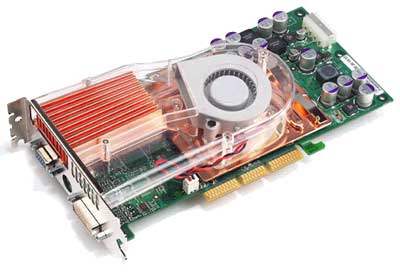GeForce FX 5800 Ultra

Looking more broadly, we can assume that when choosing a new brand in such difficult times, nVidia's marketers decided to resurrect 3dfx in the memory of ordinary people for a reason. The PR department of the company assumed that such a move would affect the popularity of accelerators. Perhaps, nVidia has finally decided that it is unprofitable to continue increasing numbers in the GeForce line - the difference between GeForce 3 and 4 was not so great, and the fact that the younger chip is called GeForce 4 MX, and thanks to this, also belongs to the line of "fourth geoforces" , can generally be considered a mistake of the marketing department.

Improved pixel shaders
Now, with the advent of FX, pixel processing has been raised to the same level of importance as vertex processing. For example, many of the commands used exclusively for vertex processing are now available for pixel processing, and the control programs themselves will be larger (up to 1024 commands). And while the GeForce3 was limited to four textures per pixel, the NV30 supported up to 16. Finally, the number of operations per pixel was drastically increased: DirectX 8 has a limit of 8 operations, and DirectX 9 announced support for 64 operations, and The NV30 supports up to 1024 texture operations. This included such advanced commands as "swizzling" (setting by addresses) and "conditional write masks" (conditional write masks).

Improved color accuracy
Another enhancement introduced with the NV3X is support for 64 and 128 bit color representation (16 or 32 bit floating point for each RGB component). This innovation is well reflected in images with a high range of brightness. This possibility has long been implemented in professional 3D applications in the form of the HDRI (High Dynamic Range Image) standard, for example, for 3D Max and is used in three-dimensional rendering of the scene by the Brazil renderer.

With a wider color gamut, artifacts have been eliminated. But for 128-bit color, I had to pay generously with hardware resources, primarily with the bandwidth of the data bus.
Cg: C programming language for graphics
One of the key elements of Nvidia's strategy to popularize graphics programming was the Cg language. Cg is a high-level programming language that Nvidia tried to make developing new programs easier, making it accessible not only to experienced people like John Carmack, but also to beginners. In the long term, this made the applications even more flexible and powerful. Cg supports both Direct3D and OpenGL, while maintaining compatibility with early graphics chips.
At SIGGRAPH, an example was shown in which a pixel shader program, consisting of only two lines in Cg, did the same thing as an impressive portion of code of 23 lines in assembler. Even a novice programmer can use Cg to program advanced graphic effects. And it's always easier to deal with a high-level language than with assembler and specific accelerator commands. High-level languages have been historically proven to stimulate and popularize software development. By the way, the Cg language compiler was distributed under an Open Source license, which also had a positive effect on its popularity.
AGP 8x
Increasing the bandwidth between system memory, processor and graphics chip was a key goal of the NV3x architecture. The chip supported AGP8x, that is, twice the bandwidth of the graphics bus. AGP8x provided speeds of 2 Gb / s, while AGP4x was only 1 Gb / s. As a result, it became possible to transfer even more data to the accelerator, load it more fully and faster with textures, complex geometric models and other data.
But the role of AGP 8x in the system should not be exaggerated. The visible benefit of the new interface did not show itself soon. Games optimized for that generation of hardware didn't get much from the AGP 8x. And only when most of the PC fleet became compatible with the new interface, applications began to work faster on AGP 8x than on AGP 2x/4x systems.
Technological process 0.13 microns
The NV30 core will be manufactured using a new 0.13 micron process. For comparison, older NV25 models, or simply GeForce 4, were produced using a 0.15 micron process. A thinner manufacturing process allowed for more transistors on a chip, increased frequency, and reduced power consumption and heat dissipation. By the way, the top product ATi Raden 9700 was also manufactured using 0.15 micron technology.
DDR II support
One of the features of the new chip that caused a lot of excitement was the basic support for second-generation DDR memory. The so-called DDR-II has become a key influence on the performance of the accelerator. It is known that it is the performance of the memory subsystem of a graphics card that often determines the performance in modern applications.

Advantages and disadvantages of the new architecture
The main quality of NVIDIA GeForce FX is increased flexibility and programmability, which exceeds the basic requirements of DirectX 9 and the capabilities of ATI RADEON 9700 Pro, but architecture flexibility and programmability turned into a decrease in performance for NVIDIA GeForce FX, and, in some aspects, a very serious decrease. The weakest point of the new chip was the lack of computing power of the arithmetic processors responsible for the execution of pixel shaders. The GeForce FX had the hardest time with DirectX9 pixel shaders using floating point calculations. The introduction of framebuffer compression made it possible to increase performance when full-screen anti-aliasing was enabled, and as a result, the performance loss on GeForce FX when full-screen anti-aliasing was enabled turned out to be much lower than that of NVIDIA GeForce 4. However ,
The first card from the FX series - GeForce FX 5800 Ultra, which went on sale and was a kind of architectural base on which a whole family of products was then based. , operating at 500 (1000) MHz, was not able to provide the 500 MHz 8-pipeline chip with the required bandwidth. This minus affected AA in the most tragic way, despite the presence of frame buffer compression in MSAA modes. The memory bandwidth of 128 bits is by no means enough to record 4000 filled pixels per second, and NVIDIA had to limit itself to 4 pixel processors and 2000 pixels. As a result, the NV30 performed noticeably worse in terms of speed in AA mode than the R300 (equipped not only with compression, but also with a wider 256-bit memory bus). Another disadvantage is the noisy cooler, which, in addition, it was able to frighten the user of that time with its sudden starts or stops (lower speed). Because of this design, the user was forced to sacrifice the first PCI slot.

Specifications NVIDIA GeForce FX 5800 Ultra
| Name | GeForce FX 5800 Ultra |
| Core | NV30 |
| Process technology (µm) | 0.13 |
| Transistors (million) | 125 |
| Core frequency | 500 |
| Memory frequency (DDR) | 500 (1000) |
| Bus and memory type | DDR II - 128bit |
| Bandwidth (Gb/s) | 16 |
| Pixel pipelines | 8(4) |
| TMU per conveyor | 12) |
| textures per clock | 8 |
| textures per pass | 16 |
| Vertex conveyors | 3 |
| Pixel Shaders | 2+ |
| Vertex Shaders | 2+ |
| Fill Rate (Mpix/s) | 4000 |
| Fill Rate (Mtex/s) | 4000 |
| DirectX | 9+ |
| Anti-Aliasing (Max) | SS&MS - 8x |
| Anisotropic Filtering (Max) | 8x |
| Memory | 128MB |
| Interface | AGP 8x |
| RAMDAC | 2x400 MHz |
Mass and popular video cards based on NVIDIA GeForce FX 5800 Ultra, in fact, did not become ....




